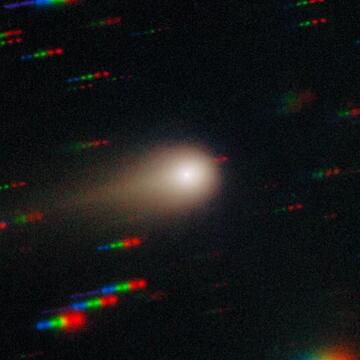On October 29, 2025, interstellar comet 3I/ATLAS which is a rare visitor from deep space, will approach Earth at its closest point. This will provide scientists with a fleeting but major opportunity to examine material from outside our Solar System.
The comet was first spotted in July 2025 by astronomers at Hawaii’s Asteroid Terrestrial-impact Last Alert System (ATLAS). It is travelling on a hyperbolic path, meaning it is not bound by the Sun’s gravity and will pass through the Solar System only once before heading back into interstellar space. It will remain at a safe distance of about 1.8 astronomical units, or roughly 167 million miles from Earth.
A visitor from another star system
Four major observatories later confirmed its interstellar origin. Its speed and unusual orbit showed that it was formed around a distant star before being ejected into open space. Theoretical physicist Michio Kaku called it “a mystery interstellar object” racing through the Solar System.
3I/ATLAS is only the third known interstellar object to be detected, following ʻOumuamua in 2017 and 2I/Borisov in 2019. Scientists say studying it could reveal how planets and comets form in other star systems.
Unusual glow and composition
The comet’s nucleus is less than one kilometre wide, surrounded by a bright coma of gas and dust. Spectroscopic readings show that traces of carbon dioxide, hydrogen cyanide and atomic nickel vapour is giving it a greenish-blue hue. These chemicals suggest it was born in an extremely cold region far from any star’s heat.
As it nears the Sun, the surface ice is turning to gas, producing strong jets of dust that stretch outward to form its glowing tail. Astronomers believe this reaction could help identify organic compounds similar to those that once reached early Earth through ancient comets.
Also Read: Wanna be a music composer? OpenAI may soon let you create songs from text prompts
Safe but short-lived visit
Scientists stress that 3I/ATLAS poses no threat to Earth. Instead, it is being hailed as a “time capsule” from another part of the galaxy. Harvard astrophysicist Avi Loeb said the comet’s unusual motion is fascinating but agreed it is a natural remnant of planetary formation.
The comet is currently too faint to see without a telescope of at least eight inches in diameter. It is expected to reappear around December 2025 once it moves away from the Sun and becomes visible again from the Northern Hemisphere under dark skies. Its name reflects its discovery, “3I” for the third interstellar object ever found, and “ATLAS” for the Hawaiian observatory that detected it.







